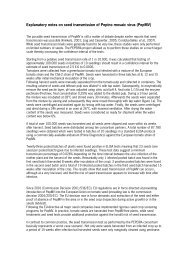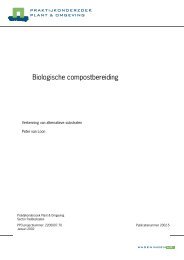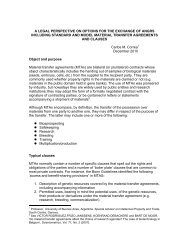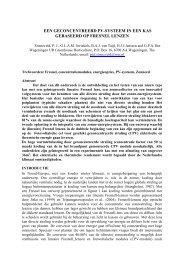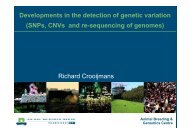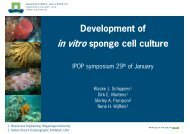Oil spill dispersant article
Oil spill dispersant article
Oil spill dispersant article
Create successful ePaper yourself
Turn your PDF publications into a flip-book with our unique Google optimized e-Paper software.
The ecological effects of <strong>spill</strong>ed<br />
oil<br />
The effects of <strong>spill</strong>ed oil on marine and shoreline<br />
creatures are caused by:<br />
• the sticky and adhesive nature of <strong>spill</strong>ed<br />
oil leading to physical contamination and<br />
smothering;<br />
The Norwegian develpoed Heli-bucket, Response<br />
3000, fi lling <strong>dispersant</strong> from supply vessel.<br />
Other countries subsequently developed<br />
similar regulations. The recent Norwegian<br />
regulations (2002) require that specifi c considerations<br />
are made regarding the environmental<br />
consequences of <strong>dispersant</strong> use as part<br />
of specifi c scenario-based contingency plans.<br />
By the mid-1970s, the principle of using <strong>dispersant</strong>s<br />
as a major oil <strong>spill</strong> response strategy<br />
was accepted by the UK and in some other<br />
countries throughout the world.<br />
<strong>Oil</strong> <strong>spill</strong>s on the 1970s, 80s and<br />
90s<br />
<strong>Oil</strong> <strong>spill</strong>s of various sizes and causes continued<br />
to happen (see example on next page). Most<br />
oil <strong>spill</strong>s are small.<br />
The amount of damage - ecological or economic<br />
- caused by an oil <strong>spill</strong> is not directly<br />
related to the amount of oil <strong>spill</strong>ed, but is<br />
more related to the properties of the oil and<br />
to the sensitivity of the resources affected. A<br />
relatively small <strong>spill</strong> of a very persistent oil in<br />
a particularly sensitive habitat (for example,<br />
a salt marsh), or at a particular time of year<br />
when some particularly sensitive resource is<br />
present (for example, the nesting season of<br />
some sea bird species), may cause far more<br />
damage than an oil <strong>spill</strong> of greater volume.<br />
• and by the chemical components of the oil<br />
causing toxic effects (acute or chronic) and<br />
accumulation of oil components in tissues<br />
leading to ‘tainting’ of fi sh fl esh.<br />
Physical oiling<br />
Spilled oil on the surface of deep water has<br />
little effect on the majority of creatures in the<br />
sea. The exceptions are sea birds; these can<br />
be badly effected by <strong>spill</strong>ed oil at sea. When<br />
sea birds come into contact with the oil they<br />
become coated in oil and their feathers lose<br />
their insulating properties. As a result they<br />
will die of exposure or may be unable to<br />
feed. Most damage caused by oil <strong>spill</strong>s occurs<br />
when the oil moves into shallow water and<br />
contaminates the shoreline. The main threat<br />
posed to inter-tidal and shoreline creatures by<br />
<strong>spill</strong>ed oils is physical smothering. The animals<br />
that are initially most at risk are those that<br />
could come into contact with a contaminated<br />
sea surface or oil stranded in inter-tidal areas.<br />
These include marine mammals and reptiles,<br />
wading birds and small crustacea and invertebrates.<br />
Spilled oil physically smothering Havert-puppies, at the<br />
Froan islands of Norway<br />
15



